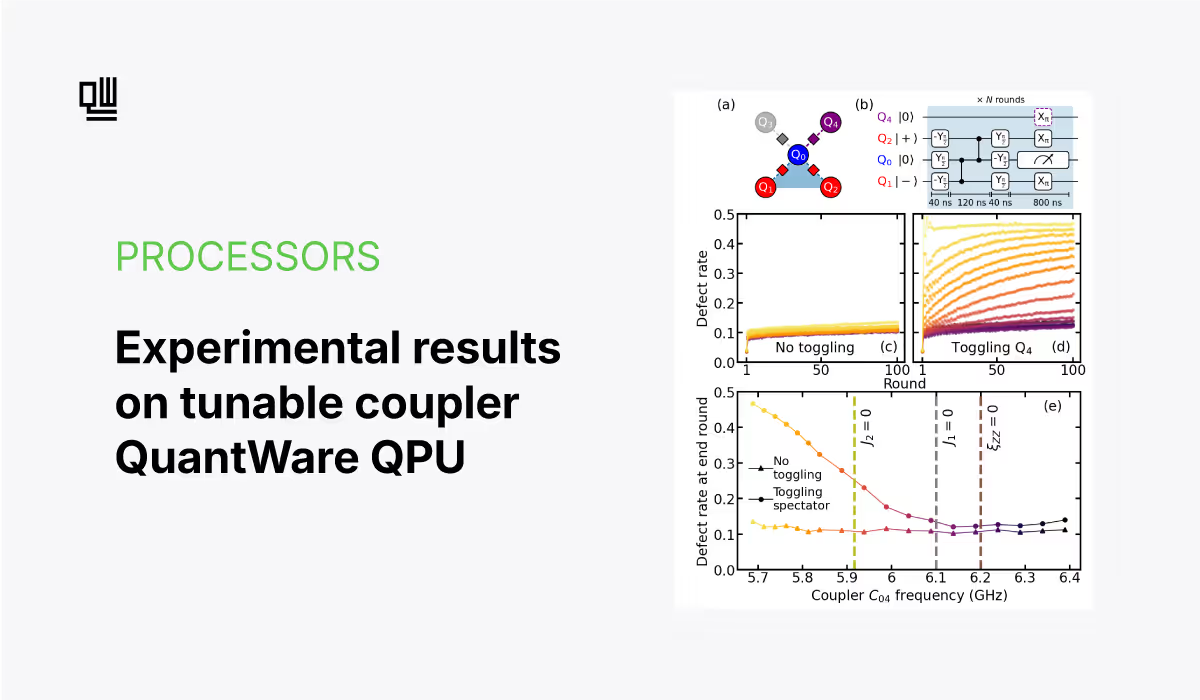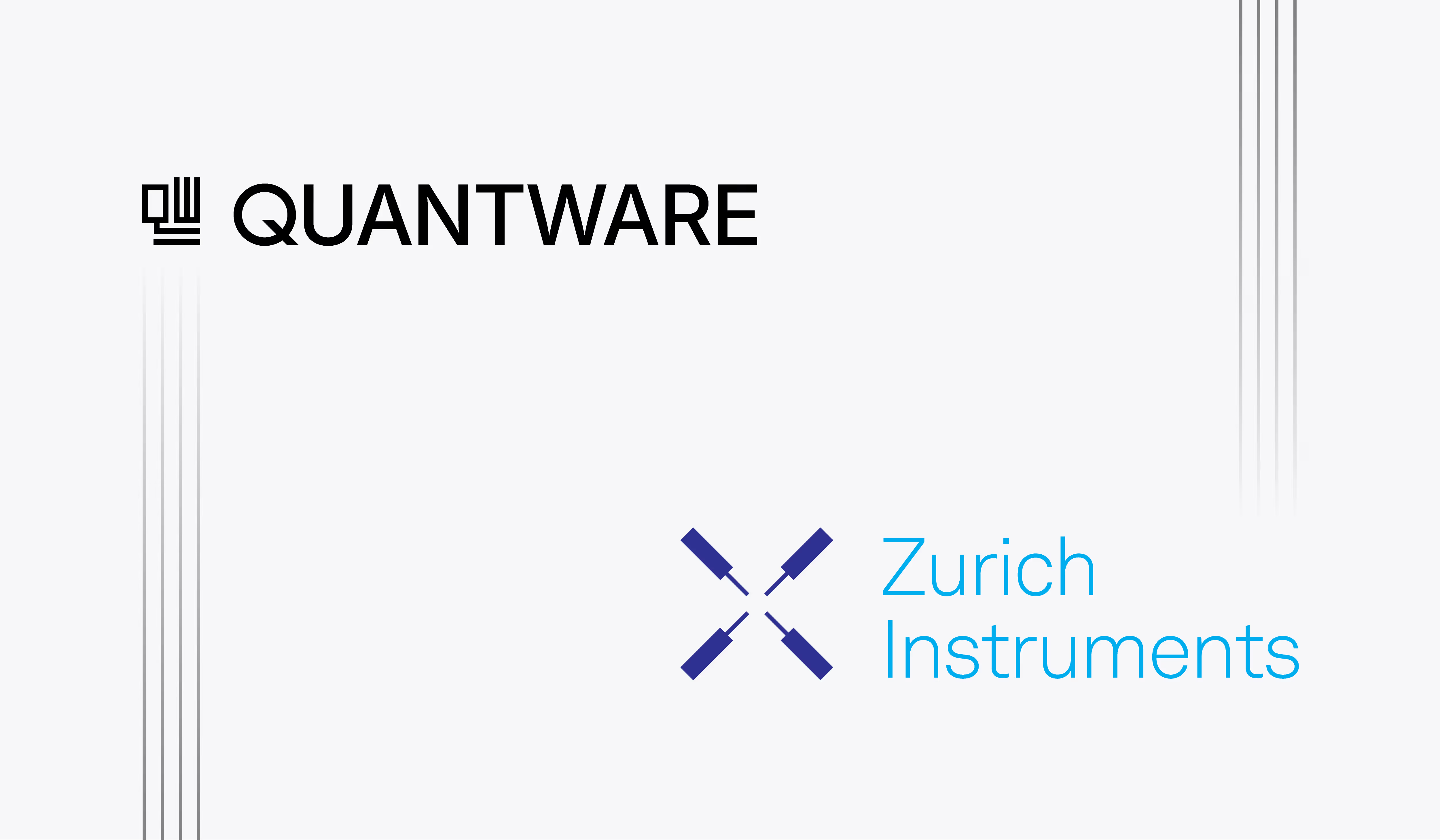
Crescendo-S TWPA x SHFPPC Parametric Pump Controller: Optimise High-Fidelity Qubit Readout with One Solution
Introduction
In quantum computing with superconducting qubits, Josephson Travelling Wave Parametric Amplifiers (TWPAs) play a central role in state readout. State readout requires extremely weak pulses transmitted by the quantum processor to be accurately measured at room temperature. To overcome thermal noise at higher-temperature stages and achieve fast and high-fidelity readout, ultra-low-noise, cryogenic signal amplification is essential. The TWPA stands as the state-of-the-art solution for this task. In contrast to Josephson Parametric Amplifiers (JPAs), TWPAs exhibit a broad bandwidth unconstrained by resonator limitations. This enables the high degree of frequency multiplexing within a single readout chain, paramount to scaling quantum computers towards advantage.
Crescendo TWPA by QuantWare
QuantWare’s Crescendo-S is a cutting-edge TWPA with state-of-the-art signal gain and noise performance. Its wide readout band enables highly multiplexed and cost-effective readout. The amplifier is designed to be flexible, scalable and easy to use. Additionally, it is available in all conventional qubit readout frequency bands. Crescendo-S requires only a single pump tone, is insensitive to magnetic fields and comes with high-density packaging.
Crescendo-E is the only enterprise-scale TWPA offering, combining the state-of-the-art performance of Crescendo-S with cost-effective, high-volume deliveries. QuantWare’s industrial production process ensures that enterprise customers can reliably source cutting-edge TWPAs for quantum computers of any scale.
SHFPPC Parametric Pump Controller by Zurich Instruments
The Zurich Instruments SHFPPC Parametric Pump Controller provides a plug-and-play solution tailored for the tune-up and stable operation of up to four parametric amplifiers. It is fully integrated into the Zurich Instruments Quantum Computing Control System (QCCS) and LabOne Q software framework. The SHFPPC provides a high-power, low-phase-noise pump tone with tested long-term stability required to operate parametric amplifiers. Additionally, it includes pump tone cancellation circuits for residual pump tone suppression and probe tone generation for convenient amplifier characterisation. These features are specifically designed for ease of use and peace of mind. They allow users to focus directly on experiments instead of amplifier operation.
Optimised Path to High-Fidelity Qubit Readout
Together, the Crescendo and the SHFPPC form an excellent combination for the effective high-fidelity readout of multiple superconducting qubits. In this blog post, we characterise and operate a Crescendo-S2 TWPA (18 dB typical gain) with a SHFPPC. Using a Zurich Instruments SHFQA+ Quantum Analyzer (or SHFQC+ Qubit Controller) to analyse the readout signal amplified by the TWPA, we demonstrate a swift and efficient tune-up of the parametric amplifier. This is enabled by the fast frequency sweeping capability of the SHFPPC combined with dedicated plug-and-play tune-up routines in LabOne Q. We find the optimal pump tone amplitude and frequency to run the Crescendo-S2 at its peak performance. Furthermore, we demonstrate how easily the spurious pump tone can be suppressed by 40 dB in the readout signal to push readout fidelities to the limit.
This joint offering further simplifies the implementation of high-fidelity readout at scale. It allows scientists to focus on what is most important: accelerating quantum innovation.
Setup
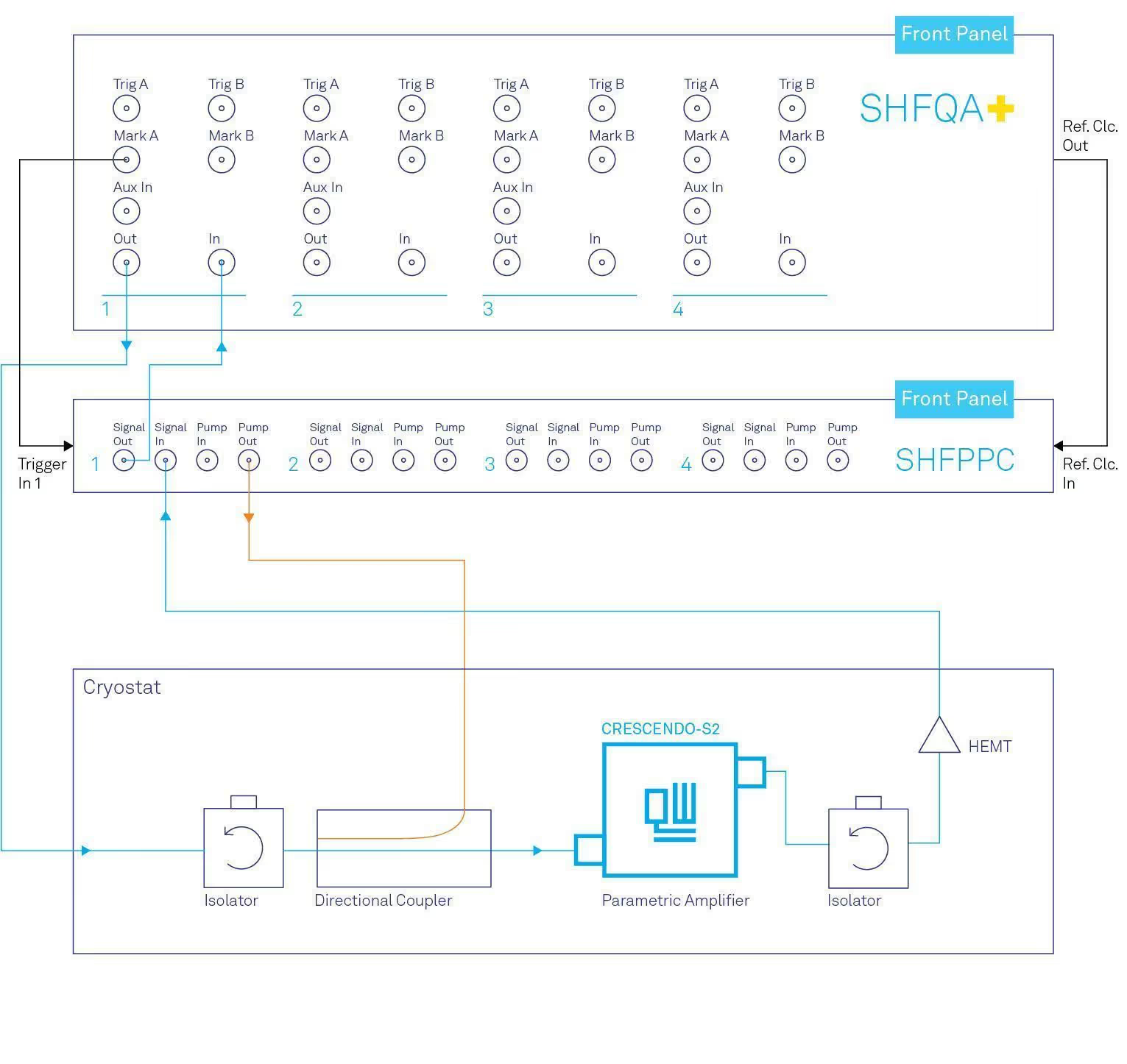
In our experiment, we control a QuantWare Crescendo-S2 TWPA using a Zurich Instruments SHFPPC. The pump signal required to operate the TWPA is generated by the SHFPPC. The readout (or probe) signal to be amplified by the TWPA is generated by a Zurich Instruments SHFQA+. To ensure a proper synchronisation between both devices, an optional 100 MHz reference clock signal is fed from the SHFQA+ to the SHFPPC. In addition, we trigger the fast firmware frequency sweeper of the SHFPPC using the SHFQA+, which is the device responsible for advancing the sweep and performing the corresponding measurement at each point.
From the room-temperature control electronics, the signals are routed into a cryostat. In the cryostat, attenuators are used on the 4K, still and MXC stages. This leads to a total attenuation of 60 dB and 40 dB on the input line and pump line, respectively. To apply the pump tone to the TWPA, we use a directional coupler. This results in an additional 20 dB of attenuation on the pump line. We use wideband isolators (4-12 GHz) with a minimum of 30 dB isolation before the directional coupler and after the TWPA.
The use of isolators is crucial for the performance of both the TWPA and the qubits, as this prevents the backpropagation of noise from higher temperature stages. Additionally, using isolators with a broad bandwidth creates a flat and broadband impedance environment ensuring optimal TWPA performance. After the amplification of the signal at the cryogenic stage by the QuantWare Crescendo-S TWPA, the signal is amplified further by a HEMT on the 4K stage before leaving the fridge.
After leaving the fridge, the signal is sent to the pump tone cancellation circuit of the SHFPPC to suppress the residual pump in the readout signal. The resulting signal is then finally sent back to the SHFQA+ for signal processing and analysis.
Experiments and Results
Using the setup described above, we proceed with the complete characterisation of a QuantWare Crescendo-S2 TWPA with a Zurich Instruments SHFPPC Parametric Pump Controller, using dedicated tune-up routines in the LabOne Q software framework.
Pump Tone Optimisation
First, we find the optimal working point of the Crescendo-S2. We do this by carefully choosing the frequency and power of its pump signal provided by the SHFPPC. We aim to maximise the average signal gain over the entire 1.0 GHz readout bandwidth of the Crescendo-S2, between 6.0 GHz and 7.0 GHz. To do this, we compare the power of a probe signal passing through the Crescendo-S2 with and without the presence of a pump tone played by the SHFPPC. This gives the corresponding signal gain. Repeating this measurement for various pump tone frequencies and powers and averaging over multiple probe tone frequencies within the Crescendo-S2 readout band leads to the result shown in Figure 1.
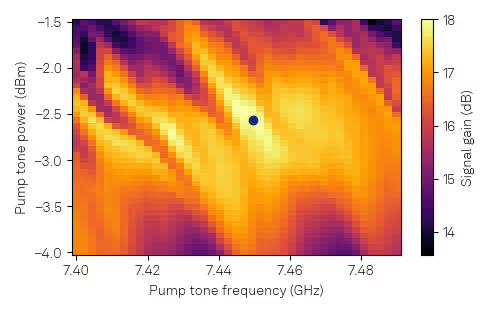
From the obtained data, we see that a large average gain of 18.0 dB over the broad 1.0 GHz readout range can be achieved when using the optimal pump tone parameters. The above measurement has been performed over 41 pump tone frequencies, 41 pump tone powers and 41 probe tone frequencies, each individual data point being averaged 512 times. This large amount of data has been acquired in under 5 minutes. This is an improvement by over a factor 2 compared to other measurement techniques using conventional signal generators and vector network analysers. Such efficiency is made possible by the fast sweeping capability of the SHFPPC in combination with the SHFQA+. This makes the SHFPPC an ideal device for the fast characterisation of parametric amplifiers.
Gain Curve
To illustrate the excellent performance of the Crescendo-S2 within its large specified readout range, we repeat the above measurement over a broad probe tone frequency range, fixing the pump tone parameters to the optimal values obtained above. The result is shown in Figure 2, which shows a typical gain profile for a TWPA. The results show the large average gain of 18.0 dB between 6.0 GHz and 7.0 GHz readout frequency.
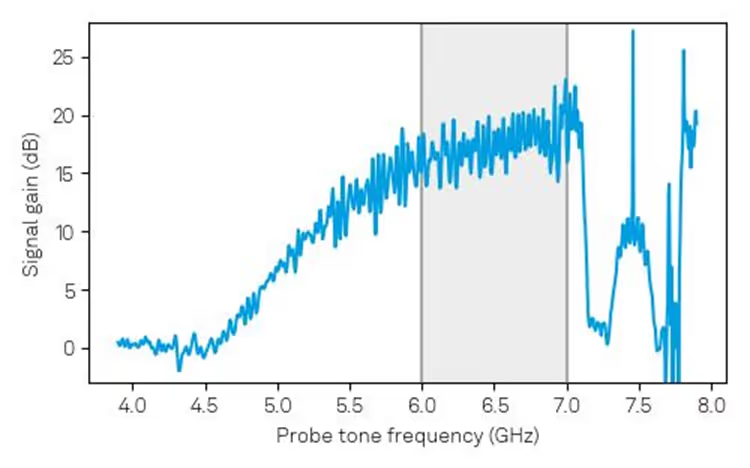
As can be seen in Figure 2, the high-power pump tone is clearly visible in the readout signal spectrum after the parametric amplifier. This spurious component can lead to a saturation of subsequent amplifiers in the readout chain. It may also interfere with the readout signal processing, potentially undermining the qubit readout fidelity. Experiments therefore generally benefit from cancelling the pump tone after the parametric amplifier. With the SHFPPC, this residual signal can be interferometrically cancelled directly inside the SHFPPC thanks to its built-in pump tone cancellation circuit.
Pump Tone Cancellation
In a last experiment, we demonstrate this on the SHFPPC by finding the optimal cancellation signal minimising the residual pump tone. Using the optimal pump parameters determined above, we measure the relative suppression of the pump tone after the internal cancellation circuit as a function of the relative attenuation and the phase of the cancellation tone with respect to the original pump tone.
The result is shown in Figure 3. For the optimal cancellation parameters, the residual pump signal can be suppressed by up to 40 dB. Even further pump tone suppression by up to 65 dB could be achieved with the SHFPPC at the cost of a finer parameter scan and therefore longer measurement.
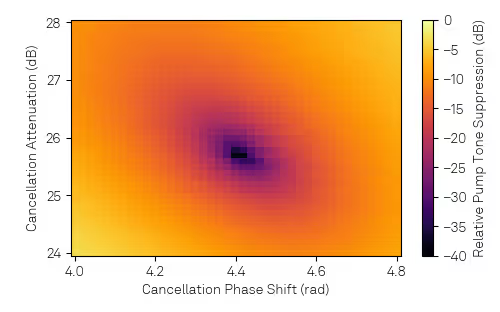
Conclusion
In this blog post, we have characterised and operated a Crescendo-S2 TWPA with a SHFPPC Parametric Pulse Controller, introducing the QuantWare Crescendo-S TWPA together with the Zurich Instruments SHFPPC Parametric Pump Controller as a complete and seamless solution for the high-fidelity and fast readout of multiple superconducting qubits. We have demonstrated the fast and easy tune-up of the TWPA in less than 5 minutes by using the SHFPPC within the LabOne Q software framework. In conclusion, this joint offering provides users with a simple implementation of scalable high-fidelity qubit readout for quantum computing and allows experts to focus on their experiments with peace of mind.
This blog post was created in collaboration with Oscar Bettermann and Michele Collodo from Zurich Instruments AG.
Ready to streamline your qubit readout? Connect with us to learn how we can optimise your system’s precision, speed, and scalability.

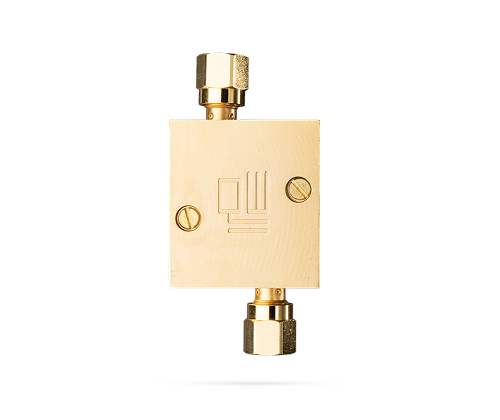

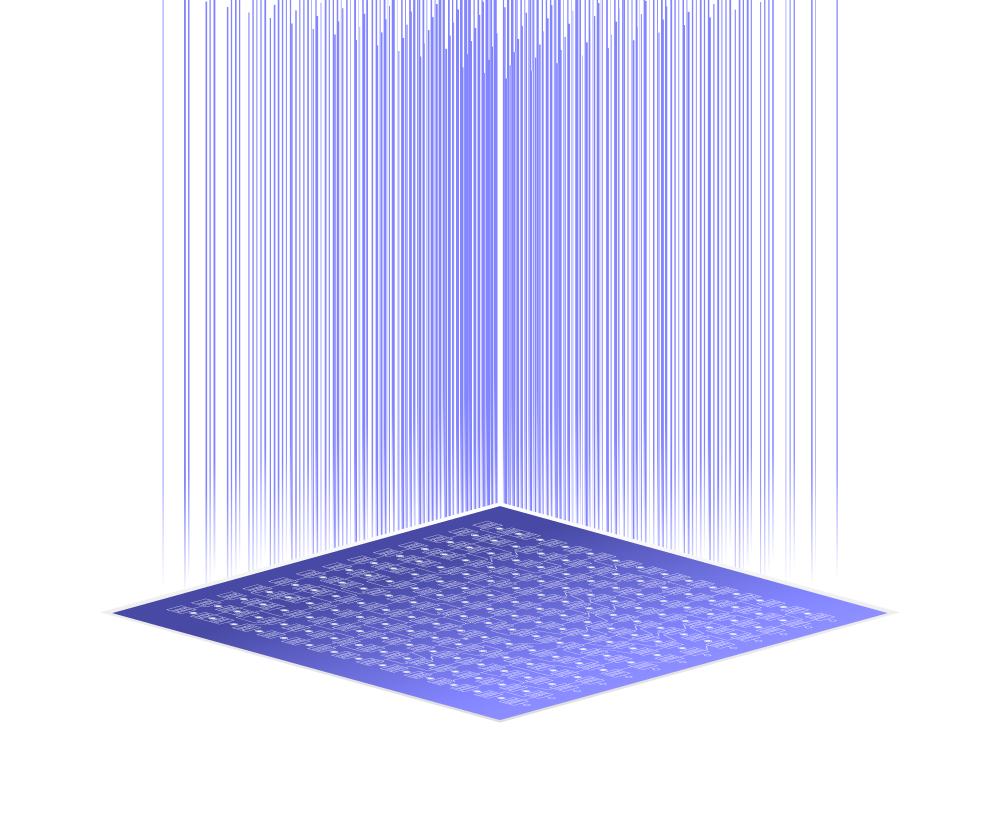
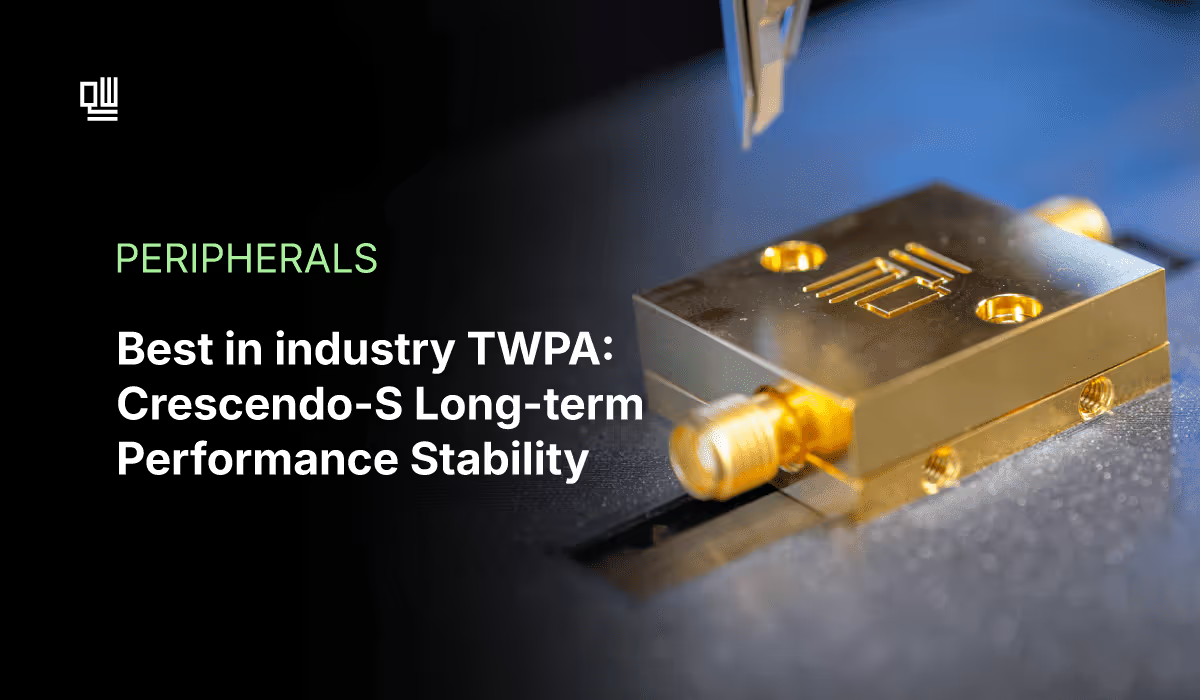
.avif)
